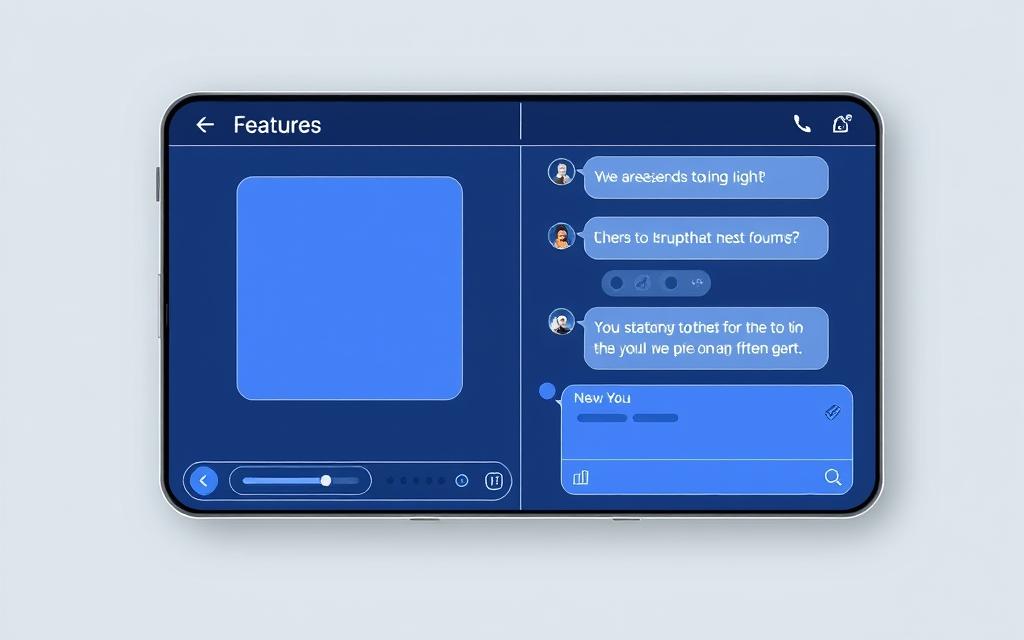Chatbots are transforming the way businesses interact with customers. These tools are no longer optional but essential for modern customer service. With the chatbot market projected to reach $102 billion by 2026, their impact is undeniable.
Consumers are embracing this technology. According to Salesforce, 69% of people prefer using chatbots for quick responses. This shift highlights the importance of delivering seamless experiences through advanced capabilities.
For businesses, investing in the right chatbot features can drive operational efficiency and improve customer satisfaction. From personalized interactions to real-time support, these tools enhance the overall experience. When implemented effectively, they also contribute to better ROI.
As the demand for automation grows, understanding the must-have features in a chatbot becomes crucial. This ensures businesses stay competitive while meeting customer expectations.
Introduction to Chatbots and Their Importance
Businesses are increasingly relying on chatbots to streamline operations. These AI-powered tools, driven by Natural Language Processing (NLP), act as conversational agents. They handle routine tasks, reducing the need for human intervention and boosting efficiency.
For example, Black Angus Steakhouse implemented a chatbot for after-hours support. This led to an 80% reduction in after-hours inquiries, freeing up staff for more critical tasks. Such success stories highlight the transformative potential of this technology.
Consumers are also embracing chatbots. According to an INSIDER survey, 44% of U.S. consumers prefer chatbots over humans for quick responses. This preference stems from their ability to provide instant issue resolution and personalized support.
Here are some key benefits of using chatbots:
| Benefit | Impact |
|---|---|
| 24/7 Availability | Ensures continuous support without downtime |
| Instant Responses | Reduces wait times and improves customer experience |
| Cost Reduction | Potential to cut operational costs by 30% |
| Employee Productivity | Frees up staff for higher-value tasks |
Companies using chatbots have reported significant improvements. An Intercom study found a 67% increase in sales among businesses leveraging this technology. This demonstrates how chatbots can drive both efficiency and revenue growth.
As automation becomes more prevalent, chatbots are proving to be essential tools. They enhance the customer experience while supporting employee productivity. By integrating these solutions, businesses can stay competitive in today’s fast-paced market.
AI-Powered Conversational Skills
Advanced conversational skills are reshaping how businesses engage with their audience. These capabilities are driven by cutting-edge technologies like Natural Language Processing (NLP) and generative AI. Together, they enable chatbots to understand and respond to user queries with remarkable accuracy.
Natural Language Processing (NLP)
NLP plays a crucial role in enabling chatbots to understand colloquial language. It interprets user inputs, even when they are informal or ambiguous. For instance, Rezolve.ai uses NLP to handle tasks ranging from login issues to payment processing. This has led to a 24% increase in customer satisfaction.
In healthcare, NLP-powered chatbots are reducing the workload of medical staff. They assist with appointment scheduling, symptom checking, and even patient follow-ups. This not only improves efficiency but also ensures patients receive timely support.
Generative AI Capabilities
Generative AI takes conversational skills to the next level. Unlike scripted bots, it creates dynamic, context-aware responses. This adaptability makes interactions feel more natural and personalized. For example, generative AI can interpret multi-language inputs, making it ideal for global businesses.
Another advantage is its ability to learn from past interactions. This ensures the chatbot improves over time, delivering better results with each conversation. Such capabilities are transforming industries, from retail to finance, by enhancing customer experiences.
By leveraging these technologies, businesses can create chatbots that are not just functional but also intuitive. This ensures they stay ahead in today’s competitive market.
24/7 Availability and Instant Responses
Round-the-clock availability is a game-changer for modern customer support. With 64% of users citing 24/7 service as a top benefit, businesses can ensure no query goes unanswered. This constant presence builds trust and reliability.
Chatbots resolve queries three times faster than human agents. For example, a remote worker needing midnight IT support can get immediate assistance. This eliminates delays and keeps operations running smoothly.
Cost efficiency is another advantage. Maintaining human agents for round-the-clock coverage is expensive. Chatbots offer a scalable solution, reducing operational costs while delivering consistent service.
Intercom data shows chatbots handle queries 67% faster. This speed is crucial in industries like finance, where response time reductions of up to 73% have been reported. Such improvements enhance customer satisfaction and loyalty.
Auto-escalation protocols ensure complex issues reach the right team. When a chatbot cannot resolve a query, it seamlessly transfers the conversation to a human agent. This balance between automation and human touch optimizes support workflows.
By leveraging 24/7 availability and instant responses, businesses can meet customer expectations efficiently. This approach not only improves service quality but also drives long-term success.
Personalization and User Data Management
Personalization is at the heart of modern customer engagement. With 85% of CX leaders prioritizing tailored experiences, businesses are leveraging user data to create meaningful interactions. This approach not only enhances satisfaction but also drives higher conversion rates.
User Attributes and Profiles
Effective personalization begins with understanding user attributes. Progressive profiling collects data over time, building detailed profiles. For example, e-commerce chatbots recommend products based on purchase history, ensuring relevance and boosting sales.
In HR, chatbots personalize onboarding flows by analyzing employee attributes. This tailored approach improves engagement and reduces turnover. CRM integration further enhances this by providing real-time insights into user behavior.
Segmentation and Targeted Responses
Segmentation divides audiences into specific segments, enabling targeted responses. Chatbots using this strategy achieve 40% higher conversion rates. For instance, healthcare chatbots send medication reminders based on patient profiles, ensuring timely care.
By combining data and segmentation, businesses can deliver highly relevant interactions. This not only meets customer expectations but also fosters long-term loyalty.
Omni-Channel Integration
Omni-channel integration is redefining customer engagement across multiple platforms. By connecting websites, social media, and messaging apps, businesses can deliver consistent experiences. This approach ensures customers interact with the brand seamlessly, regardless of the platform they use.
Social media integration alone can increase customer reach by 70%. For example, chatbots on Facebook and WhatsApp enable businesses to engage users where they already spend time. This strategy not only boosts visibility but also enhances accessibility.
Cross-channel context retention is another game-changer. It allows chatbots to remember user interactions across platforms, reducing resolution times by 58%. A customer starting a conversation on a website can continue it on WhatsApp without repeating details.
Here’s how businesses are leveraging omni-channel integration:
- Mapping the customer journey across web, WhatsApp, and Facebook for a unified experience.
- Syncing order status between chatbots and Shopify stores for real-time updates.
- Integrating with MS Teams and Slack for internal support, streamlining team communication.
- Unifying chat across seven platforms, as demonstrated by a leading bank’s case study.
- Using chatbot-collected data to auto-fill forms, saving time and improving accuracy.
These strategies ensure businesses meet customer expectations while enhancing operational efficiency. By adopting omni-channel solutions, companies can stay competitive in today’s fast-paced market.
| Platform | Benefit |
|---|---|
| Social Media | Increases customer reach by 70% |
| Messaging Apps | Enables real-time, personalized interactions |
| Internal Tools | Streamlines team communication and support |
| E-commerce Platforms | Provides real-time order updates |
Omni-channel integration is no longer optional but essential for businesses aiming to deliver exceptional customer experiences. By unifying interactions across channels, companies can build stronger relationships and drive long-term success.
Workflow Automation and Efficiency
Automation is revolutionizing how businesses handle repetitive tasks. By integrating advanced solutions, companies can streamline workflows and boost productivity. This approach not only saves time but also reduces errors, ensuring smoother operations.
For example, automating IT password resets can save up to 15 hours per week. This allows IT teams to focus on more strategic initiatives. Similarly, in manufacturing, chatbots reduce equipment downtime by monitoring and alerting teams to potential issues.
Task Automation
Task automation simplifies complex processes. In retail, chatbots autonomously process 92% of returns, ensuring faster resolutions. This efficiency enhances customer satisfaction while freeing up staff for other responsibilities.
Another example is automated meeting scheduling. By syncing with calendars, chatbots eliminate the back-and-forth of manual scheduling. This ensures meetings are set up quickly and accurately.
Integration with Enterprise Software
Integrating chatbots with enterprise software like SAP enables real-time inventory checks. This ensures businesses maintain optimal stock levels, reducing delays and improving sales.
With over 5,000 app integrations via platforms like Zapier, chatbots can connect seamlessly with existing tools. This flexibility allows businesses to customize solutions to their specific needs.
In insurance, chatbots accelerate claims handling by 73%. This speed improves customer experiences while reducing administrative burdens. By leveraging automation, businesses can achieve significant efficiency gains across industries.
Emotional Intelligence and Sentiment Analysis
Emotional intelligence is reshaping how chatbots connect with users. By understanding emotions, these tools deliver more meaningful interactions. This approach not only improves satisfaction but also builds stronger relationships.
Studies show chatbots with emotional awareness achieve 68% higher retention. They also de-escalate frustrated users 42 seconds faster. This capability ensures smoother resolutions and enhances the overall experience.
Advanced sentiment analysis enables chatbots to detect mood through voice tone or text patterns. For example, a hospitality chatbot can rebook flights for angry travelers, turning frustration into relief. Similarly, mental health bots identify crisis keywords, providing immediate support.
Apology protocols are another key feature. When service failures occur, chatbots deliver empathetic responses, acknowledging the issue and offering solutions. This approach fosters trust and loyalty.
Training data plays a crucial role in developing emotional intelligence. By analyzing diverse interactions, chatbots learn to respond with empathy and accuracy. This ensures they adapt to various scenarios, delivering consistent results.
By integrating emotional intelligence, businesses can create chatbots that truly understand their users. This not only enhances engagement but also drives long-term success.
Analytics and Reporting Tools
Analytics tools are essential for optimizing chatbot performance. By tracking over 19 KPIs, including self-service rate and CSAT, businesses gain actionable insights. These metrics help identify strengths and areas for improvement, ensuring continuous growth.
Understanding conversation drop-off points is crucial. It reveals where users disengage, allowing teams to refine chatbot flows. Similarly, analyzing peak usage times ensures adequate staffing, maintaining seamless support during high-demand periods.
Automated weekly performance reports simplify data analysis. They provide a clear overview of chatbot effectiveness, highlighting trends and anomalies. For example, A/B testing different greeting messages can reveal which approach resonates best with users.
Financial impact dashboards are another powerful tool. They calculate ROI, showing how chatbots contribute to cost savings and revenue growth. This data-driven approach helps businesses justify investments and prioritize enhancements.
With 83% of enterprises using chatbot data for process improvement, analytics are no longer optional. They empower businesses to make informed decisions, delivering better experiences and driving long-term success.
Security and Data Privacy
Ensuring robust security measures is critical for chatbot adoption. With 98% of regulated industries requiring end-to-end encryption, businesses must prioritize protecting sensitive information. This not only builds trust but also ensures compliance with global standards.
Role-based access controls are essential for safeguarding user data. By limiting access to authorized personnel, businesses can prevent unauthorized breaches. This approach is particularly vital in industries like healthcare, where chatbots must meet HIPAA standards.
GDPR-compliant data deletion protocols are another key consideration. These ensure user information is removed upon request, maintaining data privacy. For example, a healthcare chatbot can securely delete patient records after treatment, adhering to legal requirements.
Real-time fraud detection algorithms enhance security by identifying suspicious activities instantly. In finance, these algorithms reduce fraudulent transactions by 73%, protecting both businesses and customers. This proactive approach minimizes risks and ensures smoother operations.
PCI DSS compliance is crucial for chatbots handling payments. By adhering to these standards, businesses can securely process transactions without compromising user trust. ISO 27001 certification further differentiates chatbots as reliable and secure solutions.
By integrating these measures, businesses can deliver chatbot experiences that prioritize security and data privacy. This not only meets regulatory requirements but also fosters long-term customer loyalty.
Multilingual Support
Multilingual support is a cornerstone for businesses aiming to expand globally. With 53% higher engagement in multilingual markets, companies can connect with diverse audiences effectively. This capability ensures accessibility for users across different regions, fostering stronger relationships.
Enterprise solutions now support up to 137 languages, enabling seamless interactions worldwide. This includes handling regional dialects and slang, ensuring users feel understood. For example, a tourism chatbot supporting 24 languages can guide travelers effortlessly, enhancing their experience.
Automating compliance with local data laws is another critical aspect. By integrating localization workflows, businesses can adhere to regulations while maintaining efficiency. This approach minimizes risks and ensures smooth operations across borders.
Continuous translation workflows keep content updated and relevant. This ensures users receive accurate information, regardless of their language. For instance, a case study revealed a 40% EU market expansion for a company leveraging multilingual chatbots.
| Benefit | Impact |
|---|---|
| Regional Dialects | |
| Local Data Compliance | Ensures adherence to regional regulations |
| Tourism Support | Guides travelers in 24 languages |
| Market Expansion | Drives growth in global markets |
By embracing multilingual support, businesses can break barriers and connect with users worldwide. This not only improves accessibility but also drives long-term success in a global market.
Conclusion: The Future of Chatbots
The future of chatbots is brimming with potential. By 2025, 85% of customer interactions are expected to be handled by bots, driven by a $17 billion investment in conversational AI. This innovation will redefine how businesses engage with their audience.
Emerging technologies like voice and video capabilities will make interactions more dynamic. Augmented reality integration will allow users to visualize products in real-time, enhancing the shopping experience. Quantum computing promises to reduce response times to near-instantaneous levels, while autonomous decision-making prototypes will handle complex tasks seamlessly.
Businesses aiming for business growth should adopt GenAI chatbots now. These tools not only improve efficiency but also deliver personalized experiences that drive customer loyalty. As highlighted by Yellow.ai, platforms achieving over 90% automation can significantly boost productivity and reduce handling times.
Embracing these advancements ensures companies stay ahead in a competitive market. The future of chatbots is here, and it’s time to leverage their full potential.















